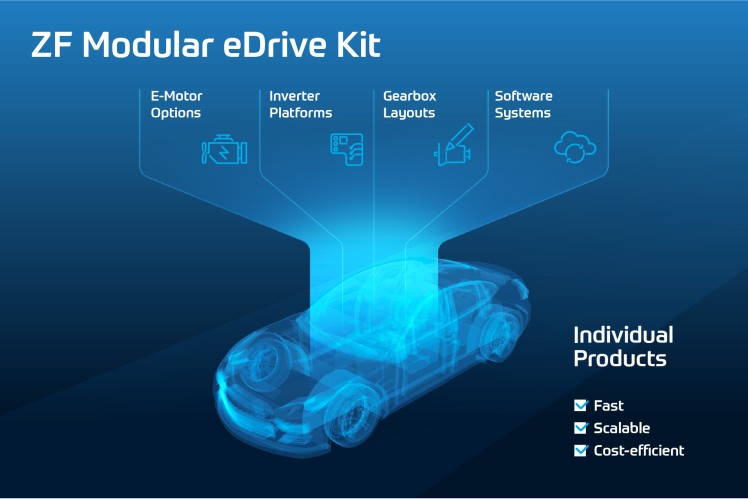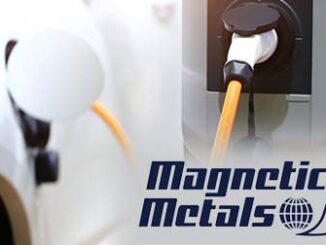
ZF presented its comprehensive portfolio of modular electrification solutions at the IAA 2021. A current volume order for the Group covers both low-emission, partially electrified and purely electric driveline technology. The world innovation “Modular eDrive Kit” serves the increasing global demand for purely electrically driven vehicles. It enables ZF to reduce the development time for new e-drives by up to 50 percent. The eConnect solution, which is also ready for series production, also saves energy and enables optional all-wheel drive. The start of series production of three new e-drives is planned by fall 2022.
With its IAA motto “Next Generation Mobility. NOW.”, ZF signals that the Group has already developed comprehensive sustainable mobility solutions for series production or series production readiness. In the electrification of the passenger car driveline, ZF supports the automotive industry with flexible solutions that match the different speeds of the international markets. For example, a current volume order worth several billion euros covers the supply of conventional, but primarily mild and plug-in hybrid variants of the fourth-generation 8-speed transmission (8HP). In addition, key components for pure electric drives such as power electronics and e-motors are also part of the scope of supply.
World premiere at the IAA
The highlight at the IAA 2021 was the “Modular eDrive Kit” for purely electric drives. This world first bundles the entire expertise of ZF’s e-mobility team for system solutions, components, and software controls in a flexible and modular platform. A major advantage of the consistent modular approach is shorter development times: “With our ‘Modular eDrive Kit’, we will achieve a halving of the development time until series production readiness in the future,” says Stephan von Schuckmann, ZF Board Member and Head of ZF Car Driveline Technology Division. In addition, the “Modular eDrive Kit” is suitable for different vehicle segments: Configurations with e-machines from 75 to 400 kW drives and from 349 to 544 Nm torque are possible and can be designed for maximum performance and efficiency. It covers everything – examples are: compact cars with 100 kW drives and 400 V inverters to premium segment, 200 kW and 800 V inverters based on silicon carbide, thus offering the greatest possible flexibility – depending on whether the focus is on cost efficiency or technology leadership. Because the system design, construction, software, electric motor concept, cooling and some components are developed on a cross-platform basis, synergy effects and a higher degree of maturity are achieved from the beginning. The basic package is based on proven ZF series technology and can be quickly supplemented or adjusted depending on specific customer requirements.
Driveline platform brings efficiency gains
The “Modular eDrive Kit” comprises three power classes as well as the “Premium” (800V SiC) and “Basic” (400V) segments. Three e-drives comprising the “Modular eDrive Kit” are about to enter series production: a “Low” drive solution below 100 kW, a “Mid” drive solution up to 200 kW – both based on ASM or PSM machines and an inverter with 400-volt technology – and a “High” solution with an output of over 200 kW, which will enter series production in the second half of 2022 and combines a PSM machine with a silicon carbide-based inverter with 800-volt technology. “All new drives bring significant improvements in power density, weight and efficiency,” emphasizes Dr. Otmar Scharrer, Senior Vice President R&D Electrified Powertrain Technology.
eConnect for all-wheel drive
The energy efficiency of the “Modular eDrive Kit” can be increased by another module: ZF eConnect is a flexible solution for all-wheel drive vehicles. The system, which is designed to be installation space-neutral, leaves the second axle uncoupled to save energy as long as it is not needed. This reduces mechanical drag losses by up to 90 percent. However, if required, eConnect can engage the second drive within milliseconds via a claw coupling without any losses. eConnect impresses with an efficiency increase of well over two percent compared with the best comparable system currently available in the market.
Predictive driving for greater efficiency
Further efficiency potential has been realized in the EVnext concept vehicle. For example, the efficient drive and recuperative braking work particularly well together with an intelligent predictive cruise control system (ACCnext). This takes into account traffic flow, traffic signals and also topographical conditions. According to its own calculations, the ZF software saves up to 13 percent energy thanks to networking with the infrastructure and special control algorithms.



